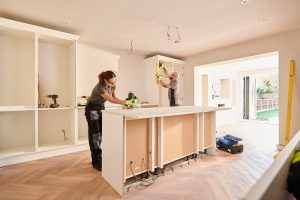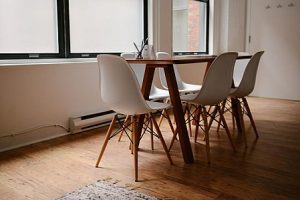Furniture plays an essential role in shaping the overall look and feel of interior spaces. It combines function, comfort, and aesthetics, and has a significant impact on how people interact with and perceive their environment. Whether you’re designing a home, office, or commercial space, the choice of furniture is a critical decision that affects the mood, practicality, and efficiency of the area. In this article, we will explore various aspects of furniture design, including its purpose, function, color, and how to effectively incorporate it into a space.
1. Understanding the Purpose of Furniture in Interior Design
Furniture serves multiple purposes, beyond just filling a room. Its primary functions are to provide comfort, structure, and organization to spaces, while also enhancing the aesthetic appeal of an interior.
- Functionality and Comfort: At its core, furniture exists to support daily activities such as sitting, sleeping, eating, and working. A well-chosen piece must not only be visually appealing but also practical for its intended use. For instance, a sofa in a living room should offer comfort for lounging and socializing, while a desk in an office should promote ergonomic efficiency for long hours of work.
- Defining Spaces: Furniture is instrumental in delineating specific areas within a room. In open-plan spaces, such as a combined kitchen and living room, furniture can help establish boundaries and distinguish between different functional zones. For example, a strategically placed sectional sofa can separate the living area from the dining space.
- Aesthetic Contribution: Furniture is a key contributor to the aesthetic and overall style of a room. Whether it’s modern, traditional, minimalist, or eclectic, the design and material of the furniture heavily influence the interior’s visual appeal.
2. Key Types of Interior Furniture
When designing interiors, understanding the various types of furniture is crucial for creating both functional and aesthetically pleasing spaces.
- Seating Furniture: This category includes sofas, chairs, benches, and stools. These pieces are essential in nearly every room, from the living room and dining area to bedrooms and home offices. The type, material, and style of seating furniture should be selected to meet the functional needs of the space while providing comfort and aesthetic appeal.
- Storage Furniture: Cabinets, shelves, wardrobes, and drawers help to maintain order and organization within a room. They serve both practical and decorative purposes, allowing for easy access to everyday items while also contributing to the room’s overall look.
- Tables: Dining tables, coffee tables, desks, and side tables are functional pieces that are central to daily activities. The design of a table can range from simple and utilitarian to highly decorative, depending on the room’s intended function and design theme.
- Beds and Bedroom Furniture: The bed is the focal point of any bedroom, and its design sets the tone for the room. Beds should prioritize comfort and style, while complementary pieces like nightstands, dressers, and wardrobes provide storage and functionality.
- Lighting Fixtures and Accessories: Though not traditionally categorized as furniture, lighting plays a significant role in interior design. Floor lamps, table lamps, and hanging lights should be selected to complement the furniture, providing both illumination and decorative value.
- Recently I found a good site https://www.pntrac.com/t/4-479246-329981-264053, which sells a lot of furniture styles, and the price is also very affordable, the site’s discounts are also very large, my own home renovation also bought a lot of furniture on it, there is a need to also click in to see

3. Choosing Furniture Colors: Impact on Interior Design
Color is a powerful design element in furniture selection, influencing the overall ambiance and mood of a space. The color palette chosen for furniture should harmonize with the room’s walls, flooring, and accessories while reflecting the desired atmosphere.
- Neutral Tones: Neutral furniture in shades of beige, gray, or white can provide a calming, versatile foundation for a room. These colors are timeless and flexible, making it easy to change up the decor with different accent pieces like cushions, rugs, or curtains. Neutral furniture works well in minimalist or Scandinavian design themes, where simplicity and functionality are key.
- Bold and Vibrant Colors: Brightly colored furniture, such as vibrant red or deep blue, adds personality and energy to a room. However, it’s important to balance these bold choices with more muted surroundings to avoid overwhelming the space. In rooms that require more excitement or drama—such as a lounge or dining room—bold furniture can become a striking focal point.
- Natural Wood and Earth Tones: Wooden furniture brings warmth and texture into a space. The color of wood—whether it’s light oak, medium-tone walnut, or dark mahogany—should complement the room’s style and color palette. Light wood furniture works well in contemporary, beachy, or Scandinavian interiors, while dark wood pieces suit more traditional or formal spaces.
- Monochrome and Contrast: For a clean, sophisticated look, many designers opt for monochrome color schemes, such as black and white furniture. Combining contrasting colors (like a dark table with light chairs) can add depth and interest to the design.
4. Functionality: Matching Furniture to Its Use
Selecting furniture should always begin with considering how the space will be used. Here’s how to approach different areas in your home or office:
- Living Room: In the living room, comfort and socialization are the main priorities. Sofas and seating should offer relaxation and support, while coffee tables, entertainment centers, and storage pieces should serve practical purposes. Consider sectional sofas for larger spaces or more compact seating options in smaller rooms.
- Bedroom: The bedroom should be a sanctuary for rest and relaxation, so the furniture must contribute to a calming environment. The bed should be comfortable and stylish, while the accompanying pieces like nightstands and dressers should offer practical storage without crowding the room.
- Dining Area: Dining furniture must prioritize comfort and usability while fitting the space. A dining table should be proportional to the room size, with chairs that are both comfortable and supportive. Extendable tables or space-saving designs work well in smaller dining areas.
- Home Office: Functionality is key in a home office. A comfortable, ergonomic chair and a spacious desk are essential for productivity. Storage options like bookshelves and filing cabinets should help maintain organization without cluttering the room.
5. Tips for Decorating with Furniture
Incorporating furniture into your interior design requires a thoughtful balance of aesthetics, practicality, and comfort. Here are some professional tips to help you achieve a well-designed space:
- Scale and Proportion: Ensure that the furniture is proportionate to the size of the room. Overly large pieces can overwhelm a small space, while tiny furniture in a large room may feel inadequate. Pay attention to the scale of each item and how it interacts with the surrounding space.
- Focal Points: Establish one or two focal points in each room and arrange your furniture around them. In the living room, this could be a sofa or a fireplace; in the bedroom, it’s typically the bed. A focal point draws attention and provides a visual anchor for the rest of the room’s design.
- Layering Textures and Materials: Use a mix of materials, textures, and finishes to add depth to your interior. For instance, pairing a sleek, leather sofa with a soft, plush rug or combining wooden tables with metal accents can create visual interest.
- Balance Comfort with Aesthetic Appeal: It’s essential to strike a balance between comfort and design. While a piece may look stunning, it must also be comfortable and functional. Prioritize pieces that are ergonomically sound and suit the lifestyle of the room’s users.
- Maintain Cohesion: Stick to a design theme or style to create cohesion in your space. Whether it’s modern, rustic, or industrial, maintaining a consistent style helps the room feel more polished and organized.
6. Conclusion
Furniture is more than just an assortment of functional objects in a space—it is the cornerstone of interior design, affecting both the look and utility of the room. The right pieces can elevate an ordinary space into one that is stylish, comfortable, and highly functional. When selecting furniture, consider the color, material, scale, and functionality in relation to the room’s overall design. With careful planning and attention to detail, anyone can create a harmonious and aesthetically pleasing environment with the right furniture choices.









